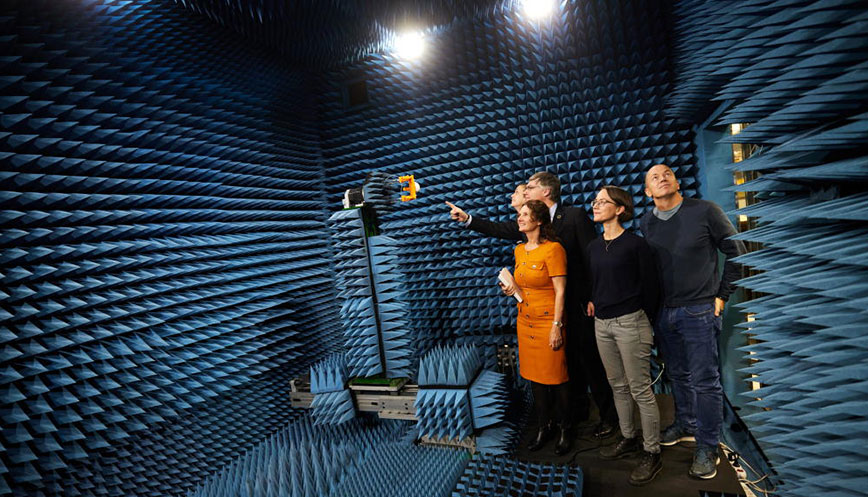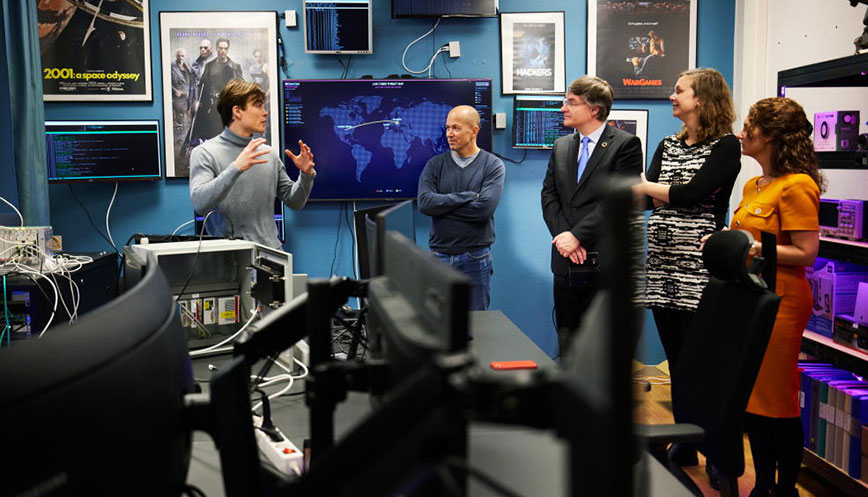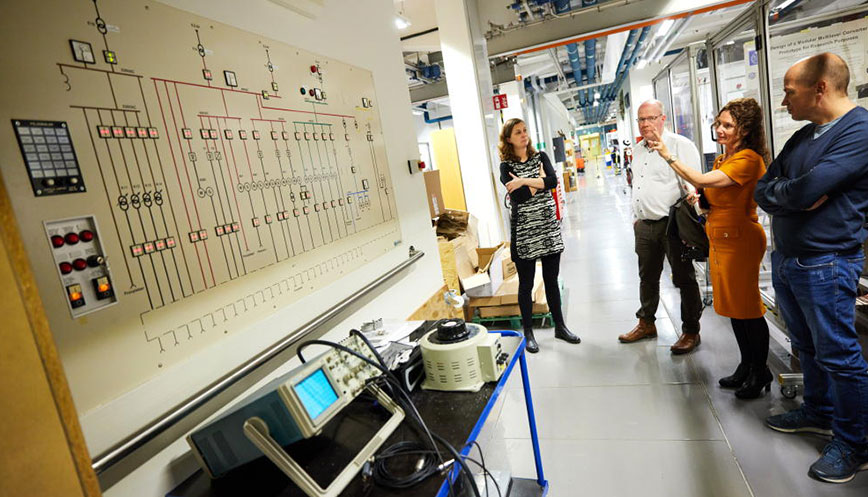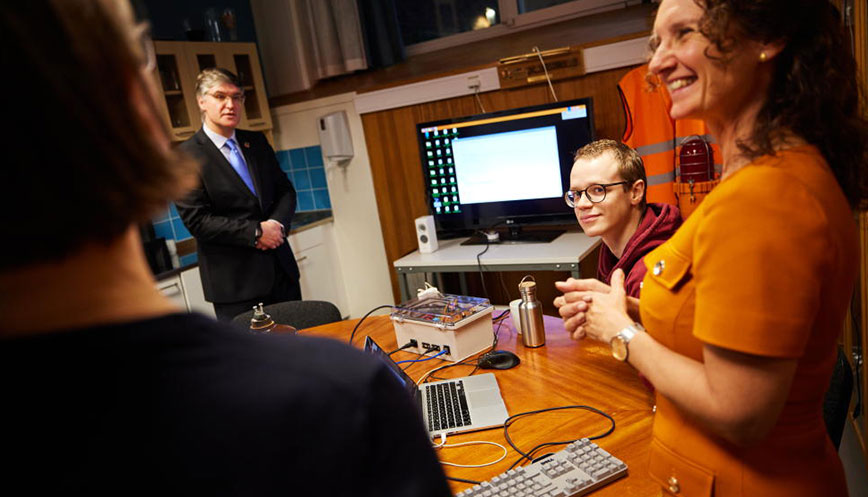Energy Platform given extensive lab tour at EECS

When KTH Energy Platform visited the School of Electrical Engineering and Computer Science (EECS) in November, we were given an orientation about various departments’ activities in the energy field and a tour of three of the school’s labs.
The Energy Platform was welcomed by Professor Hans Edin, Head of Department of Electrical Engineering (EE); Lennart Söder, Professor of Electrical Power Systems; György Dán, Professor of Teletraffic Systems; Oscar Quevedo Teruel, Professor of Electromagnetic Engineering; Elina Eriksson, Senior Lecturer in Human-Computer Interaction in Sustainability; and Fredrik Heilig, a doctoral student.
Representing KTH Energy Platform were Lina Bertling Tjernberg, KTH Energy Platform director (and EECS professor); Christophe Duwig, deputy director of KTH Energy Platform; Pierre Bodin, research advisor for strategic initiatives; Pernilla Hagbert, ABE school representative; Kerstin Forsberg, from the School of Engineering Sciences in Chemistry (CBH); Helena Mayer, communicator for KTH’s research platforms; and Susanna Berglund, co-ordinator for KTH’s research platforms.
Head of Department Hans Edin opened the visit by speaking about the Department of Electrical Engineering, which consists of five divisions; Electronics and Embedded Systems, Electromagnetic Engineering, Electric Power and Systems Engineering, Fusion Plasma Physics and Space Plasma Physics.
Extensive activities operations in electrical power
The Division of Electric Power and Systems Engineering focuses on areas such as electricity markets, renewable electricity production and integration, power system dynamics, operation and control, power electronics and applications, electrical units and applications in electric transport and resilient communication and control systems.
Electronics and Embedded Systems works on embedded systems, electronics, integrated components and circuits as well as industrial and medical electronics. This division is located on the KTH Kista campus, which the Energy Plattform visited in 2019 .
The Division of Electromagnetic Engineering conducts research and education in basic electrical engineering theory and the physical and technical foundations of electrical components. Fusion Plasma Physics works with the development of fusion reactors, ( the Energy Platform visited the department in 2019 ); and Space Plasma Physics focuses on plasma in space and in the laboratory.
The department has a total of about 40 teachers and about 100 doctoral students.

Close co-operation with industry
Professor Lennart Söder then provided an overview of work conducted by the Department of Electrical Engineering where Lina Bertling Tjernberg is also active. Projects range from the smallest power components to the development of electric vehicles and electricity supply for the transport sector, to providing insights into Sweden’s and Europe’s electricity supply.
The department has close collaborations with industry as well as educational collaborations with other departments at KTH. Professor Bertling Tjernberg highlighted the department’s co-operation and exchange with the power industry such as ABB and Hitachi Energy, as well as with transmission and distribution operators such as Svenska Kraftnät, Vattenfall, E.ON and Ellevio. In addition, researchers participate in a variety of research projects and centres such as SweGRIDS, StandUP and a number of EU-funded projects. Interdisciplinary co-operation is particularly important to move progress in the energy sector forward.
During the visit, the Department of Human-Centered Technology was represented by senior lecturer Elin Eriksson. She works at Human Center Technologies that includes research on visualizations and user-centered design, including interfaces in electric vehicles. Work is also conducted on behavioural science and new strategies for behavioural change.
IT vulnerabilities in the energy systems of the future
The Department of Computer Science was represented by Professor György Dán, who has worked to improve IT security in the energy system for many years. He gave a presentation on the subject and said that there are many parts of the energy system that are vulnerable. In addition, digitalisation creates more vulnerabilities as more functions are introduced to control and monitor energy systems.
Here are several examples of how data can be manipulated to hijack or deceive automatic control systems, insecure communication solutions and identification systems for electric vehicles that can be disrupted.

Our tour then started with a visit to the KTH Cybersecurity Lab, where doctoral student Fredrik Heiding made some introductory remarks. The futuristic lab houses workplaces as well as a plethora of different technical gadgets and installations. Communication systems for cars, electric scooters and robotic vacuum cleaners fill the shelves. There is even a luggage X-ray machine used at airports. Everything is used to understand and analyze the safety of everyday connected gadgets. Research and education conducted here also includes safety issues within connected industrial control systems, as well as the IT infrastructure in electrical grid systems. The department has also recently started offering a Master’s degree in cyber security.
Sustainable energy development in the lab
The tour then continued with Hans Edin and Lina Bertling Tjernberg taking participants to the Sustainable Power Laboratory (SPL). This is where research and education in electric power technology is conducted with prototype development and the testing of power electronics, electrical machines and drive systems. The lab is packed with modern measuring equipment and simulators for analyzing and developing new applications and technologies, including tomorrow’s electric vehicles.

SPL also has a high-voltage lab where research focuses on high-voltage insulation materials and components in electric power systems. The lab has equipment for lightning discharges, wireless power transmission and electrostatic experiments. Research conducted here includes work on clarifying how different units in high-voltage networks age over time.
SPL is widely used in teaching and houses equipment and lab benches for student work. The lab is also used in KTH’s investment in lifelong learning where people from the industry are offered competence development.

The tour and visit wrapped up in the Antenna/Microwaves Lab under the direction of Professor Oscar Quevedo Teruel. The lab consists of an echo-free chamber for measuring electromagnetic antennas. The chamber is widely used in collaboration with industry to test new applications and uses of new radio technologies such as 5G.
Organizations that conduct work at the lab include Ericsson, SAAB and the European Space Agency.
Text: Magnus Trogen Phalén